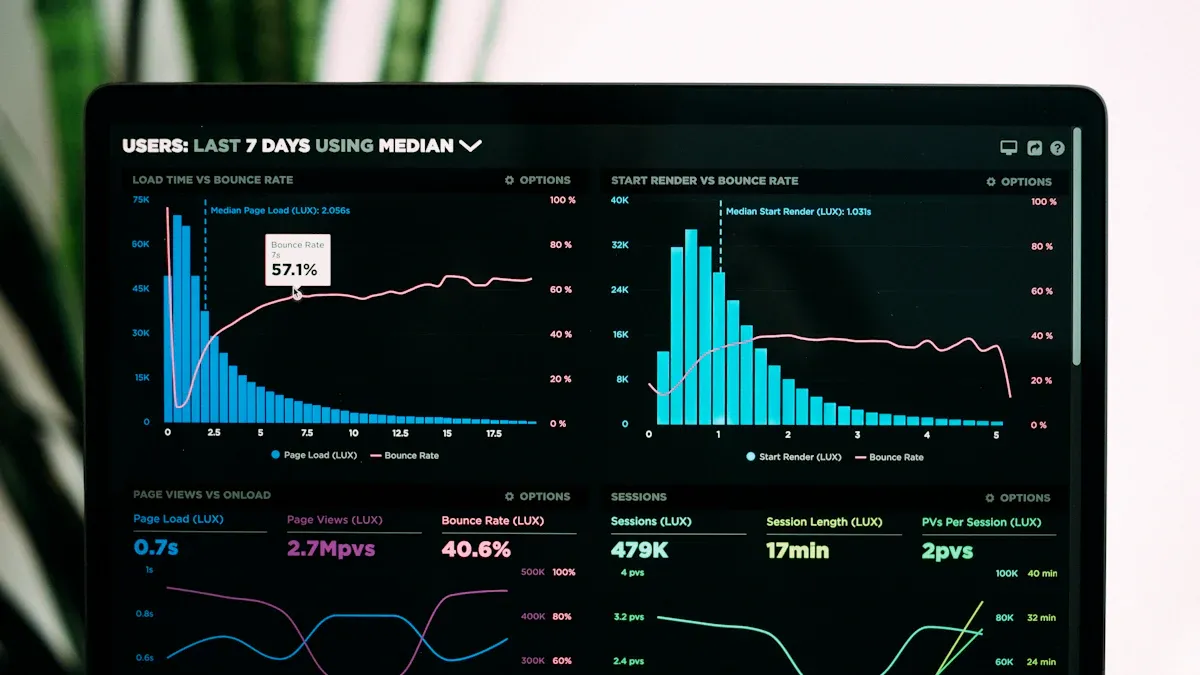How to Measure Generative Engine Optimization
Measure Generative Engine Optimization with key metrics like visibility, sentiment, and performance to improve AI search rankings and user engagement.


Measuring Generative Engine optimization helps businesses succeed online today. Making content better for AI tools like ChatGPT and Google AI can increase your brand's visibility by 40%. AI search engines change how people search and show short, interesting content first. Tools like Geneo help track rankings and coverage in real-time, ensuring your plan matches what users want. Since AI-made summaries are the future, focusing on content visibility through the Measure Generative Engine is key to earning more and staying ahead.
Key Takeaways
Measuring Generative Engine Optimization (GEO) helps your brand get noticed. It can increase visibility by up to 40%. Improve content for AI tools to stay ahead.
Use visibility tools to see how often your content shows up in AI searches. Tools like Geneo give updates to adjust your plan.
Sentiment analysis shows how people feel about your content. Good feedback makes your brand look better and improves your strategy.
Performance metrics, like clicks and conversions, show how well your content works. More engagement can help your rankings on search engines.
Test and improve your GEO strategies often. Try small tests first to find good ideas before using them in bigger markets.
Key Metrics to Measure Generative Engine Optimization

Knowing the right metrics helps you check your optimization success. These metrics show how well your content works on AI platforms. They also reveal how people feel about your brand. Let’s look at the key metrics to focus on.
Visibility Metrics: Checking AI Search Rankings and Coverage
Visibility metrics show how often your content appears in AI searches. They also tell you where your content ranks. Tracking these metrics ensures your content matches what users want. Tools like Geneo make it easy to see rankings in real-time. They work with platforms like ChatGPT, Perplexity, and Google AI Overview.
Good content gets steady rankings, no matter the location. For example:
A correlation of 0.001 shows distance doesn’t affect rankings in AI Overviews.
Quality and authority matter more for visibility than location.
Rankings differ by industry. Some stay steady, while others change often.
By using these metrics, you can boost visibility and reach the right audience.
Sentiment Analysis: Learning How Users Feel
Sentiment analysis checks how people feel about your content. Positive feelings mean your content connects well with your audience. This improves your brand’s image. It’s important for generative engine optimization because it helps refine your strategy.
Sentiment tools score how users feel, with higher scores showing positive feedback.
For instance, high sentiment scores mean users find your content useful and interesting.
By tracking sentiment, you can spot areas to improve and meet user needs better.
Performance Metrics: Measuring Engagement, Traffic, and Conversions
Performance metrics show how well your content drives actions. These include clicks, visits, and purchases. High engagement often leads to better Google rankings, helping your optimization efforts.
Studies show brands on Google’s first page have a 0.65 correlation between visibility and conversions. This shows why SEO and GEO matter.
Conversion rates measure how well your content meets goals like sign-ups or sales.
Easy-to-read and relevant content boosts engagement. Tools like Google Analytics 4 help track these metrics and improve your plan.
By focusing on performance metrics, you can make your content stronger and grow your business.
Best Practices for Using GEO Tracking Systems
Using AI Tools Like Geneo for Instant Updates
AI tools like Geneo make tracking content performance easier. They give instant updates about rankings on AI search platforms. For example, Geneo’s Visibility Dashboard shows how your brand ranks on ChatGPT and Google AI. This helps you see how your content is doing and adjust plans to improve.
Watching rankings in real-time keeps you ahead of others. Geneo compares past data with current results to find trends. These insights help you improve visibility and earn more money.
Adding GEO Metrics to CRM and Analytics Tools
Adding GEO metrics to tools like Google Analytics 4 makes tracking easier. It keeps data accurate and reduces mistakes. For example, construction companies cut errors by 30% and worked faster by 20% using this method.
This also speeds up creating proposals and improves bid accuracy. Combining GEO and SEO data creates a strong plan for your goals. It boosts Google rankings and improves overall results.
Setting Goals for GEO Success
Setting clear goals helps measure GEO success. Goals show progress and areas to fix. Companies like John Holland use data tracking to work better and follow rules. J&M Contracting uses tracking to find stolen tools and lower insurance costs.
To set goals, focus on visibility, engagement, and conversions. Use tools like Geneo to track these and compare them to industry averages. This keeps your strategy effective as AI search changes.
Overcoming Challenges in Measuring Generative Engine Optimization
Fixing Data Gaps and Differences in AI Search Results
AI search results often vary, making tracking hard. These changes happen because of algorithms, user choices, and regional data. To fix this, create good content that matches AI needs. Use structured data on trusted sites to help AI understand your content. Backlinks from reliable sources show expertise. Watching brand mentions, even without links, helps track visibility.
Tools like Geneo give quick updates on AI crawler actions. They show which platforms use your content and highlight trends. This helps you adjust your plan to keep rankings steady. It ensures your efforts work well, even with missing data.
Handling Multi-Channel Attribution Challenges
Tracking user actions across channels can be tricky. Different metrics, device issues, and privacy rules make it harder. To solve this, use models that fit your needs:
Single-touch models give credit to one action for simple insights.
Multi-touch models share credit across steps for detailed tracking.
Data-driven models use AI to study user actions for better accuracy.
Mixing these models with good tracking captures AI visits and trends. This helps you see how each channel supports your goals.
Using AI-Generated Data the Right Way
AI data is helpful, but you must use it carefully. Privacy and ownership rules mean handling data responsibly. Follow laws like GDPR or CCPA to protect users. Be clear about how you collect and use data to build trust.
Don’t trick AI with false content. Instead, make honest, helpful material for users. Ethical actions protect your brand and ensure lasting success in generative engine optimization.
Actionable Strategies to Improve Generative Engine Optimization

Making Content Better for AI and Long-Tail Keywords
Improving your content for AI and long-tail keywords helps visibility. AI platforms like clear, simple, and user-focused content. Using easy words and smooth sentences makes it better for users and AI. Tools like Geneo can find keywords that work well with AI searches.
Strategy | What It Means |
|---|---|
Explaining ideas in an easy-to-read way. | |
Fixing Errors | Making sure the text is smooth and correct. |
Adding Good Keywords | Putting useful keywords naturally in the content. |
Linking Sources | Adding links to trusted websites for proof. |
Sharing Numbers | Using data to support your points. |
Quoting Experts | Including quotes from experts to add trust. |
Unique Words | Using special words to make content stand out. |
Using Niche Terms | Showing knowledge by using specific industry terms. |
Building Trust | Writing in a way that makes readers believe you. |
Real-life examples show this works. Bankrate used AI content to get 125,000 visitors monthly. Randy Selzer boosted traffic by 80% in four months. These cases prove that focusing on AI needs and long-tail keywords brings results.
Writing for Conversations and User Needs
AI search engines now focus on conversational questions. Writing content that answers these questions clearly helps rankings. Make your content sound natural and answer specific questions directly. This improves both rankings and user happiness.
Data shows this works well. Adding sources increases visibility by 34%. Using numbers boosts it by 41%. Fixing errors improves it by 29%. But stuffing too many keywords hurts performance. So, use keywords naturally.

To meet user needs, study what people search for. Tools like Google Analytics and SEMrush help you see what users want. By understanding their needs, you can make content that keeps them interested and drives more actions.
Testing and Improving GEO Plans Regularly
Testing and improving your GEO strategies is very important. Testing shows what works and what doesn’t. Don’t decide too early—wait for the test to finish for better results.
Geo experiments, or Matched Market Tests (MMTs), are helpful for checking strategies. These tests save money and help grow successful ideas. For example:
Check how well your campaigns work.
Expand good ideas to bigger markets.
Look at both short-term and long-term results to see the full impact. Compare changes to a control group to find what really works. This process helps keep your GEO strategies strong and ready for AI search changes.
Tracking generative engine optimization helps your business stay ahead online. By checking metrics like visibility, sentiment, and performance, you can improve content for AI searches. Tools like Geneo make this easier with real-time updates and tips. As AI search changes, staying flexible is very important. Create content that focuses on users and use smart tools to stay competitive.
FAQ
What is Generative Engine Optimization (GEO)?
GEO helps your content show up on AI search engines. It makes sure your content ranks higher and reaches the right people. This is done by matching AI rules and what users like.
How does Geneo help with GEO?
Geneo gives quick updates about your rankings on AI searches. It tracks how visible your content is and suggests ways to improve. This helps you stay ahead in AI-driven searches.
Why are visibility metrics important for GEO?
Visibility metrics tell how often your content shows in AI searches. They help you see your ranking and check if your content fits user needs. This boosts your brand’s reach and engagement.
Can GEO improve conversions?
Yes, GEO makes your content more useful and easier to find. This brings more visitors, which can lead to more clicks and sales. It helps you reach your business goals.
How often should you update your GEO strategy?
You should check and change your GEO plan often. AI rules change fast, so testing and updating keeps your content ready and competitive.
See Also
Steps for Successfully Implementing Generative Engine Optimization
Understanding the Concept of Generative Engine Optimization
Key Ethical Issues Surrounding Generative Engine Optimization
The Importance of Generative Engine Optimization for B2B SaaS
Balancing HIPAA Compliance with Generative Engine Optimization





